An Improved Quantitative Analysis Method for the Unequal Supply and Demand of Ecosystem Services and Hierarchical Governance Suggestions
Abstract
1. Introduction
- (1)
- For an accurate assessment of supply and demand inequality, we propose an improved Gini coefficient that incorporates spatial proximity and clustering effects into the assessment of local inequality. It effectively mitigates the interference of spatial variations and improves the accuracy of the assessment results.
- (2)
- In terms of urban compactness, we develop an urban compactness index (UCI) based on the coefficient of variation term, integrating multiple dimensions, such as population, economy, and urban land use, into a cohesive expression.
- (3)
- In ecological governance, we embed multi-scale analysis results into a hierarchical ecological governance framework, focusing on the specificity, effectiveness, and locality of hierarchical ecosystem management at different decision-making levels, ensuring the customization and practicality of environmental governance approaches.
2. Materials and Methods
2.1. Study Area and Data
2.2. Improved ES Supply–Demand Inequality Assessment
2.2.1. Grid ES Supply–Demand Model
2.2.2. Gini Coefficient and Lorenz Asymmetry Coefficient
2.2.3. Local Gini Coefficient
2.3. Urban Compactness Index
2.4. Statistical Analysis
3. Results
3.1. Global Inequality Estimates
3.2. Local Inequality Estimates
3.3. Global and Local Regression Results
4. Discussion
4.1. Impact of ES Supply–Demand Inequality on Ecological Management System
4.2. Driving Factors and Spatial Heterogeneity of ES Supply–Demand Inequality
4.3. Regional Ecological Governance Should Adopt a Spatially Based Hierarchical Layout
4.4. Contributions and Limitations
5. Conclusions
Supplementary Materials
Author Contributions
Funding
Data Availability Statement
Conflicts of Interest
References
- Costanza, R.; de Groot, R.; Braat, L.; Kubiszewski, I.; Fioramonti, L.; Sutton, P.; Farber, S.; Grasso, M. Twenty years of ecosystem services: How far have we come and how far do we still need to go? Ecosyst. Serv. 2017, 28, 1–16. [Google Scholar] [CrossRef]
- González-García, A.; Palomo, I.; González, J.A.; López, C.A.; Montes, C. Quantifying spatial supply-demand mismatches in ecosystem services provides insights for land-use planning. Land Use Policy 2020, 94, 104493. [Google Scholar] [CrossRef]
- Hou, Y.; Müller, F.; Li, B.; Kroll, F. Urban-Rural Gradients of Ecosystem Services and the Linkages with Socioeconomics. Off. J. Int. Assoc. Landsc. Ecol. (IALE-D), Landsc. Online 2015, 39, 1–31. [Google Scholar] [CrossRef]
- Reid, W.; Mooney, H.; Cropper, A.; Capistrano, D.; Carpenter, S.; Chopra, K. Millennium Ecosystem Assessment: Ecosystems and Human Well-Being: Synthesis; Island Press: Washington, DC, USA, 2005. [Google Scholar]
- Kundu, D.; Pandey, A. World Urbanisation: Trends and Patterns. In Developing National Urban Policies; Springer: Singapore, 2020; pp. 13–49. [Google Scholar]
- Giannetti, B.F.; Agostinho, F.; Almeida, C.M.V.B. Chapter 2—Sustainable development and its goals. In Assessing Progress Towards Sustainability; Teodosiu, C., Fiore, S., Hospido, A., Eds.; Elsevier: Amsterdam, The Netherlands, 2022; pp. 13–33. [Google Scholar]
- He, G.; Zhang, L.; Wei, X.; Jin, G. Scale effects on the supply–demand mismatches of ecosystem services in Hubei Province, China. Ecol. Indic. 2023, 153, 110461. [Google Scholar] [CrossRef]
- Xia, H.; Yuan, S.; Prishchepov, A.V. Spatial-temporal heterogeneity of ecosystem service interactions and their social-ecological drivers: Implications for spatial planning and management. Resour. Conserv. Recycl. 2023, 189, 106767. [Google Scholar] [CrossRef]
- Su, R.; Duan, C.; Chen, B. The shift in the spatiotemporal relationship between supply and demand of ecosystem services and its drivers in China. J. Environ. Manag. 2024, 365, 121698. [Google Scholar] [CrossRef]
- Maimaiti, B.; Chen, S.; Kasimu, A.; Simayi, Z.; Aierken, N. Urban spatial expansion and its impacts on ecosystem service value of typical oasis cities around Tarim Basin, northwest China. Int. J. Appl. Earth Obs. Geoinf. 2021, 104, 102554. [Google Scholar] [CrossRef]
- Qu, H.; You, C.; Wang, W.; Guo, L. Spatio-temporal interplay between ecosystem services and urbanization in the Yangtze River Economic Belt: A new perspective for considering the scarcity effect. Land Use Policy 2024, 147, 107358. [Google Scholar] [CrossRef]
- Sylla, M.; Hagemann, N.; Szewrański, S. Mapping trade-offs and synergies among peri-urban ecosystem services to address spatial policy. Environ. Sci. Policy 2020, 112, 79–90. [Google Scholar] [CrossRef]
- Zhou, L.; Zhang, H.; Bi, G.; Su, K.; Wang, L.; Chen, H.; Yang, Q. Multiscale perspective research on the evolution characteristics of the ecosystem services supply-demand relationship in the chongqing section of the three gorges reservoir area. Ecol. Indic. 2022, 142, 109227. [Google Scholar] [CrossRef]
- Zhu, D.F.; Cao, H.; Luo, G.Y.; Pan, H.; Luo, C.Y. Simplified calculation and design method of multi-well system for anti-uplifting based on intercepting and discharging water. Yantu Gongcheng Xuebao/Chin. J. Geotech. Eng. 2021, 43, 1986–1993. [Google Scholar] [CrossRef]
- Raudsepp-Hearne, C.; Peterson, G.D. Scale and ecosystem services: How do observation, management, and analysis shift with scale—Lessons from Québec. Ecol. Soc. 2016, 21, 16. [Google Scholar] [CrossRef]
- Liu, M.; Xiong, Y.; Zhang, A. Multi-scale telecoupling effects of land use change on ecosystem services in urban agglomerations —A case study in the middle reaches of Yangtze River urban agglomerations. J. Clean. Prod. 2023, 415, 137878. [Google Scholar] [CrossRef]
- Yi, D.; Guo, J.; Pueppke, S.G.; Han, Y.; Ding, G.; Ou, M.; Koomen, E. What dominates the variation of ecosystem services across different urban expansion patterns?—Evidence from the Yangtze River Delta region, China. Environ. Impact Assess. Rev. 2025, 110, 107674. [Google Scholar] [CrossRef]
- Chen, Y.; Ge, Y.; Yang, G.; Wu, Z.; Du, Y.; Mao, F.; Liu, S.; Xu, R.; Qu, Z.; Xu, B.; et al. Inequalities of urban green space area and ecosystem services along urban center-edge gradients. Landsc. Urban Plan. 2022, 217, 104266. [Google Scholar] [CrossRef]
- Wu, S.; Zheng, X.; Wei, C. Measurement of inequality using household energy consumption data in rural China. Nat. Energy 2017, 2, 795–803. [Google Scholar] [CrossRef]
- Bickenbach, F.; Bode, E. Disproportionality Measures of Concentration, Specialization, and Localization. Int. Reg. Sci. Rev. 2008, 31, 359–388. [Google Scholar] [CrossRef]
- Shi, Z.; Huang, H.; Wu, Y.; Chiu, Y.-H.; Qin, S. Climate Change Impacts on Agricultural Production and Crop Disaster Area in China. Int. J. Environ. Res. Public Heal. 2020, 17, 4792. [Google Scholar] [CrossRef]
- Teng, Y.; Chen, G.; Su, M.; Zhang, Y.; Li, S.; Xu, C. Ecological management zoning based on static and dynamic matching characteristics of ecosystem services supply and demand in the Guangdong–Hong Kong–Macao Greater Bay Area. J. Clean. Prod. 2024, 448, 141599. [Google Scholar] [CrossRef]
- Tobler, W.J.E.G. A Computer Movie Simulating Urban Growth in the Detroit Region. Econ. Geogr. 1970, 46, 234–240. [Google Scholar] [CrossRef]
- Wang, J.; Zhai, T.; Lin, Y.; Kong, X.; He, T. Spatial imbalance and changes in supply and demand of ecosystem services in China. Sci. Total Environ. 2019, 657, 781–791. [Google Scholar] [CrossRef] [PubMed]
- Sun, X.; Tang, H.; Yang, P.; Hu, G.; Liu, Z.; Wu, J. Spatiotemporal patterns and drivers of ecosystem service supply and demand across the conterminous United States: A multiscale analysis. Sci. Total Environ. 2020, 703, 135005. [Google Scholar] [CrossRef] [PubMed]
- Wang, Y.; Cai, Y.; Xie, Y.; Zhang, P.; Chen, L. Dissecting ecosystem services distribution and inequality of typical cities in China. J. Clean. Prod. 2023, 415, 137800. [Google Scholar] [CrossRef]
- Yu, P.; Zhang, S.; Yung, E.H.K.; Chan, E.H.W.; Luan, B.; Chen, Y. On the urban compactness to ecosystem services in a rapidly urbanising metropolitan area: Highlighting scale effects and spatial non–stationary. Environ. Impact Assess. Rev. 2023, 98, 106975. [Google Scholar] [CrossRef]
- Yu, S.; Leichtle, T.; Zhang, Z.; Liu, F.; Wang, X.; Yan, X.; Taubenböck, H. Does urban growth mean the loss of greenness? A multi-temporal analysis for Chinese cities. Sci. Total Environ. 2023, 898, 166373. [Google Scholar] [CrossRef]
- Li, M.; Liang, D.; Xia, J.; Song, J.; Cheng, D.; Wu, J.; Cao, Y.; Sun, H.; Li, Q. Evaluation of water conservation function of Danjiang River Basin in Qinling Mountains, China based on InVEST model. J. Environ. Manag. 2021, 286, 112212. [Google Scholar] [CrossRef]
- Xing, X.; Shi, W.; Wu, X.; Liu, Y.; Wang, X.; Zhang, Y. Towards a more compact urban form: A spatial-temporal study on the multi-dimensional compactness index of urban form in China. Appl. Geogr. 2024, 171, 103368. [Google Scholar] [CrossRef]
- Peng, J.; Tian, L.; Liu, Y.; Zhao, M.; Hu, Y.n.; Wu, J. Ecosystem services response to urbanization in metropolitan areas: Thresholds identification. Sci. Total Environ. 2017, 607–608, 706–714. [Google Scholar] [CrossRef]
- Xie, G.D.; Zhen, L.; Lu, C.X.; Xiao, Y.; Chen, C. Expert knowledge based valuation method of ecosystem services in China. J. Nat. Resour. 2008, 23, 911–919. [Google Scholar]
- Xu, Z.; Peng, J.; Qiu, S.; Liu, Y.; Dong, J.; Zhang, H. Responses of spatial relationships between ecosystem services and the Sustainable Development Goals to urbanization. Sci. Total Environ. 2022, 850, 157868. [Google Scholar] [CrossRef]
- Henderson, J.V.; Nigmatulina, D.; Kriticos, S. Measuring urban economic density. J. Urban Econ. 2021, 125, 103188. [Google Scholar] [CrossRef]
- Zhu, C.; Zhang, X.; Zhou, M.; He, S.; Gan, M.; Yang, L.; Wang, K. Impacts of urbanization and landscape pattern on habitat quality using OLS and GWR models in Hangzhou, China. Ecol. Indic. 2020, 117, 106654. [Google Scholar] [CrossRef]
- Lu, B.; Ge, Y.; Shi, Y.; Zheng, J.; Harris, P. Uncovering drivers of community-level house price dynamics through multiscale geographically weighted regression: A case study of Wuhan, China. Spat. Stat. 2023, 53, 100723. [Google Scholar] [CrossRef]
- Lu, Z.; Li, W.; Yue, R. Investigation of the long-term supply–demand relationships of ecosystem services at multiple scales under SSP–RCP scenarios to promote ecological sustainability in China’s largest city cluster. Sustain. Cities Soc. 2024, 104, 105295. [Google Scholar] [CrossRef]
- Lu, B.; Charlton, M.; Harris, P.; Fotheringham, A.S. Geographically weighted regression with a non-Euclidean distance metric: A case study using hedonic house price data. Int. J. Geogr. Inf. Sci. 2014, 28, 660–681. [Google Scholar] [CrossRef]
- Boithias, L.; Acuña, V.; Vergoñós, L.; Ziv, G.; Marcé, R.; Sabater, S. Assessment of the water supply:demand ratios in a Mediterranean basin under different global change scenarios and mitigation alternatives. Sci. Total Environ. 2014, 470–471, 567–577. [Google Scholar] [CrossRef]
- Yin, D.; Yu, H.; Shi, Y.; Zhao, M.; Zhang, J.; Li, X. Matching supply and demand for ecosystem services in the Yellow River Basin, China: A perspective of the water-energy-food nexus. J. Clean. Prod. 2023, 384, 135469. [Google Scholar] [CrossRef]
- Geneletti, D. Assessing the impact of alternative land-use zoning policies on future ecosystem services. Environ. Impact Assess. Rev. 2013, 40, 25–35. [Google Scholar] [CrossRef]
- Kroll, F.; Müller, F.; Haase, D.; Fohrer, N. Rural–urban gradient analysis of ecosystem services supply and demand dynamics. Land Use Policy 2012, 29, 521–535. [Google Scholar] [CrossRef]
- Baró, F.; Palomo, I.; Zulian, G.; Vizcaino, P.; Haase, D.; Gómez-Baggethun, E. Mapping ecosystem service capacity, flow and demand for landscape and urban planning: A case study in the Barcelona metropolitan region. Land Use Policy 2016, 57, 405–417. [Google Scholar] [CrossRef]
- Larondelle, N.; Lauf, S. Balancing demand and supply of multiple urban ecosystem services on different spatial scales. Ecosyst. Serv. 2016, 22, 18–31. [Google Scholar] [CrossRef]
- Li, J.; Geneletti, D.; Wang, H. Understanding supply-demand mismatches in ecosystem services and interactive effects of drivers to support spatial planning in Tianjin metropolis, China. Sci. Total Environ. 2023, 895, 165067. [Google Scholar] [CrossRef] [PubMed]
- Gao, Y.; Wang, Z.; Li, C. Assessing spatio-temporal heterogeneity and drivers of ecosystem services to support zonal management in mountainous cities. Sci. Total Environ. 2024, 954, 176328. [Google Scholar] [CrossRef] [PubMed]
- Lu, B.; Charlton, M.; Fotheringhama, A.S. Geographically Weighted Regression Using a Non-Euclidean Distance Metric with a Study on London House Price Data. Procedia Environ. Sci. 2011, 7, 92–97. [Google Scholar] [CrossRef]
- Chen, J.; Kinoshita, T.; Li, H.; Luo, S.; Su, D.; Yang, X.; Hu, Y. Toward green equity: An extensive study on urban form and green space equity for shrinking cities. Sustain. Cities Soc. 2023, 90, 104395. [Google Scholar] [CrossRef]
- Guan, J.; Wang, R.; Van Berkel, D.; Liang, Z. How spatial patterns affect urban green space equity at different equity levels: A Bayesian quantile regression approach. Landsc. Urban Plan. 2023, 233, 104709. [Google Scholar] [CrossRef]
- Yu, C.; Zhou, J.; Zhang, Z. Exploring the classification of China’s ecosystem service networks and their driving factors based on current status and evolutionary trends. Appl. Geogr. 2024, 168, 103321. [Google Scholar] [CrossRef]

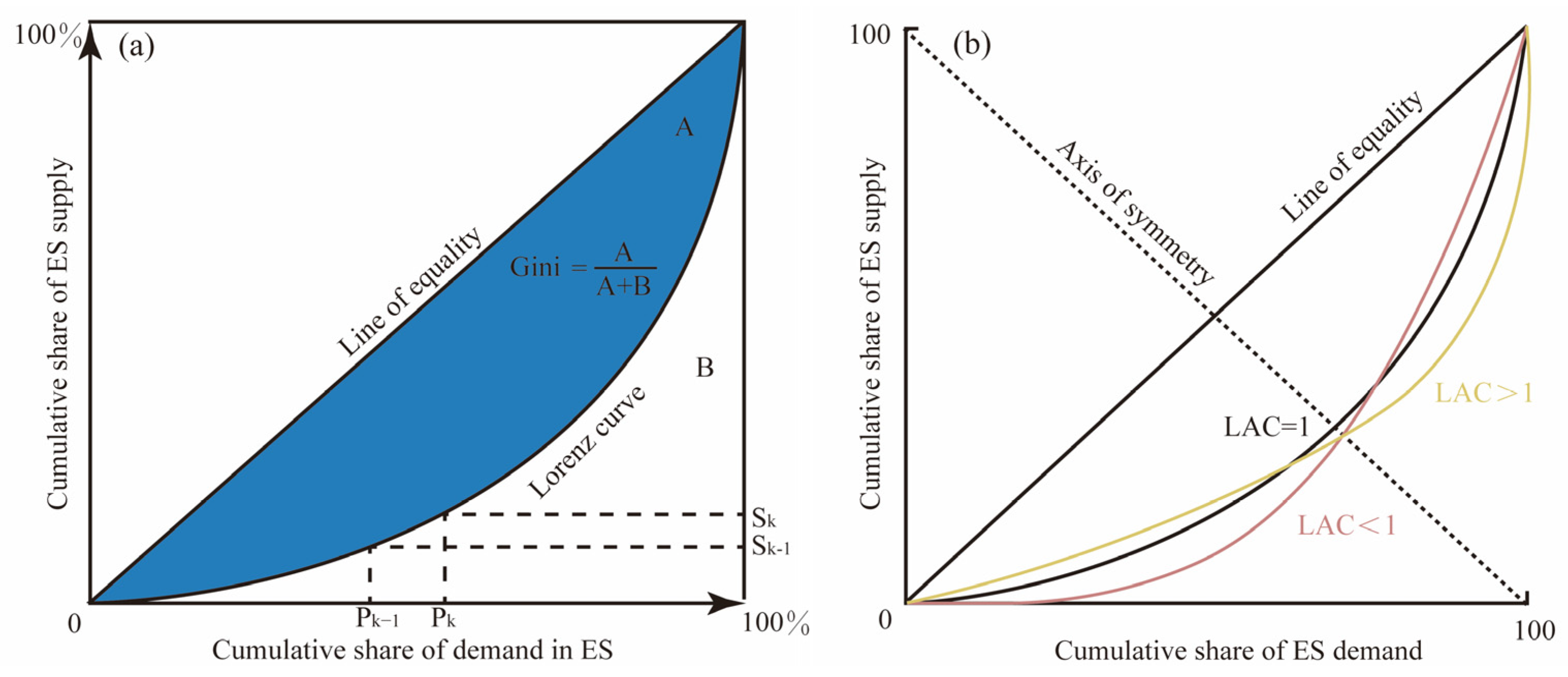
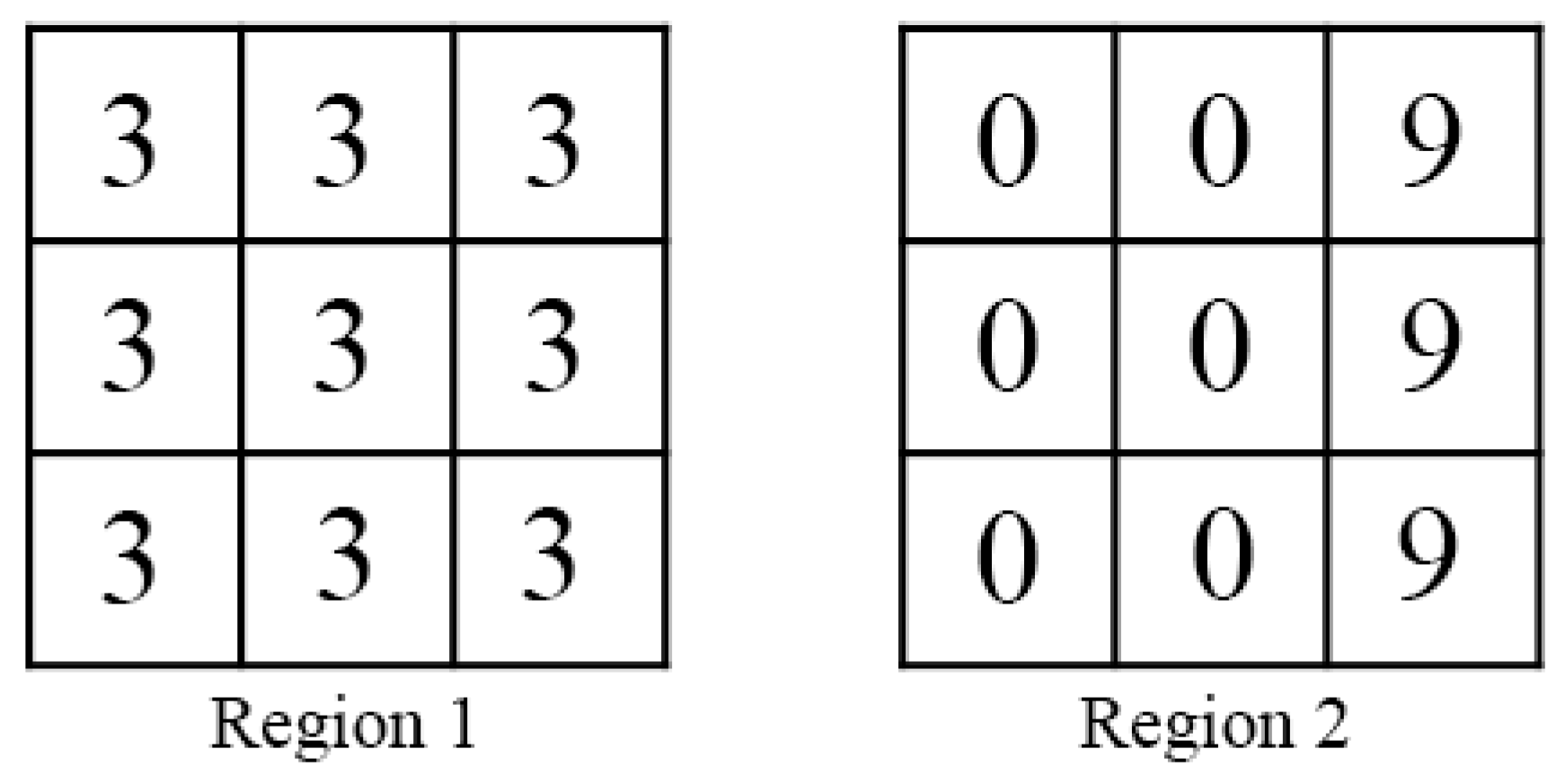
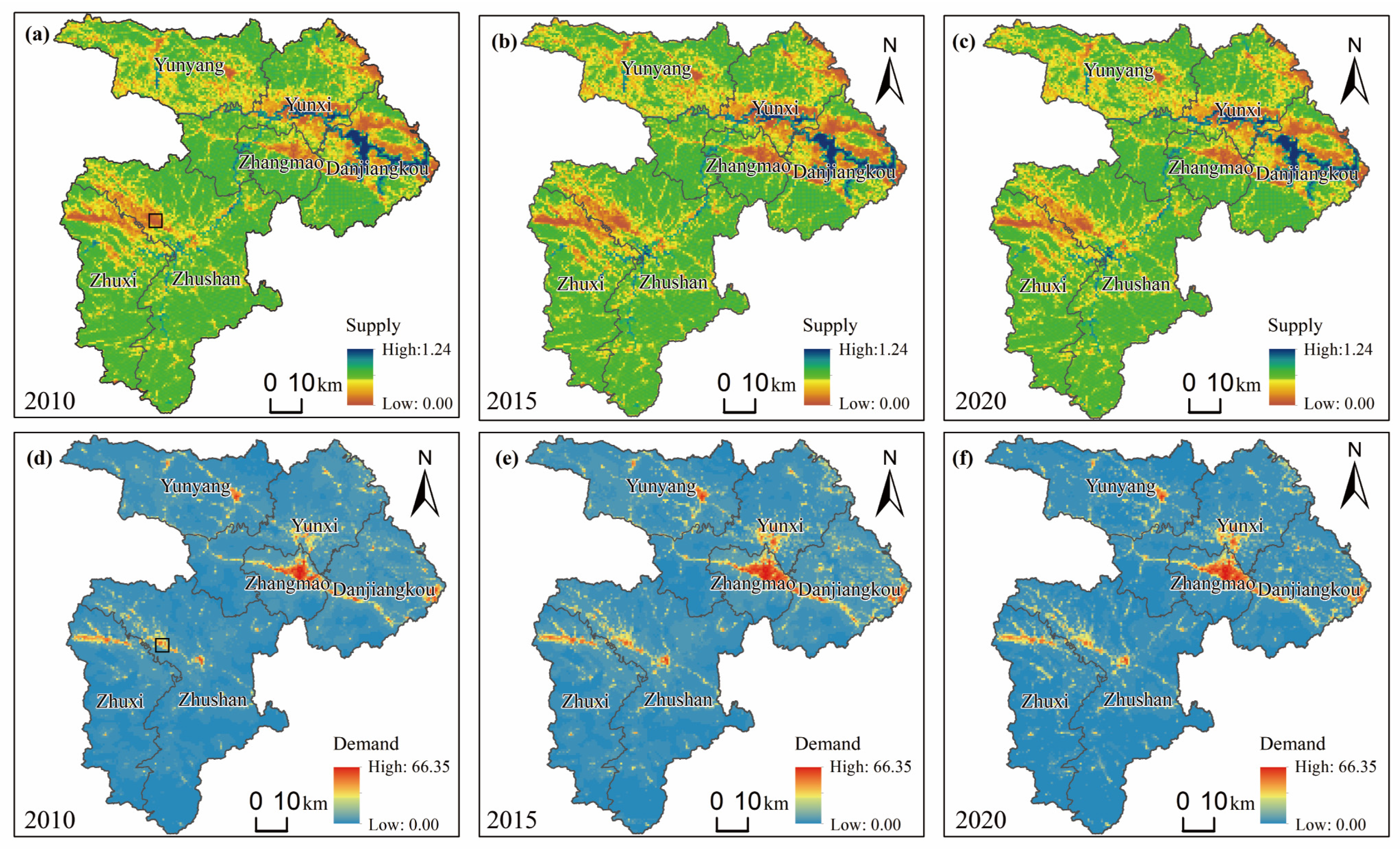
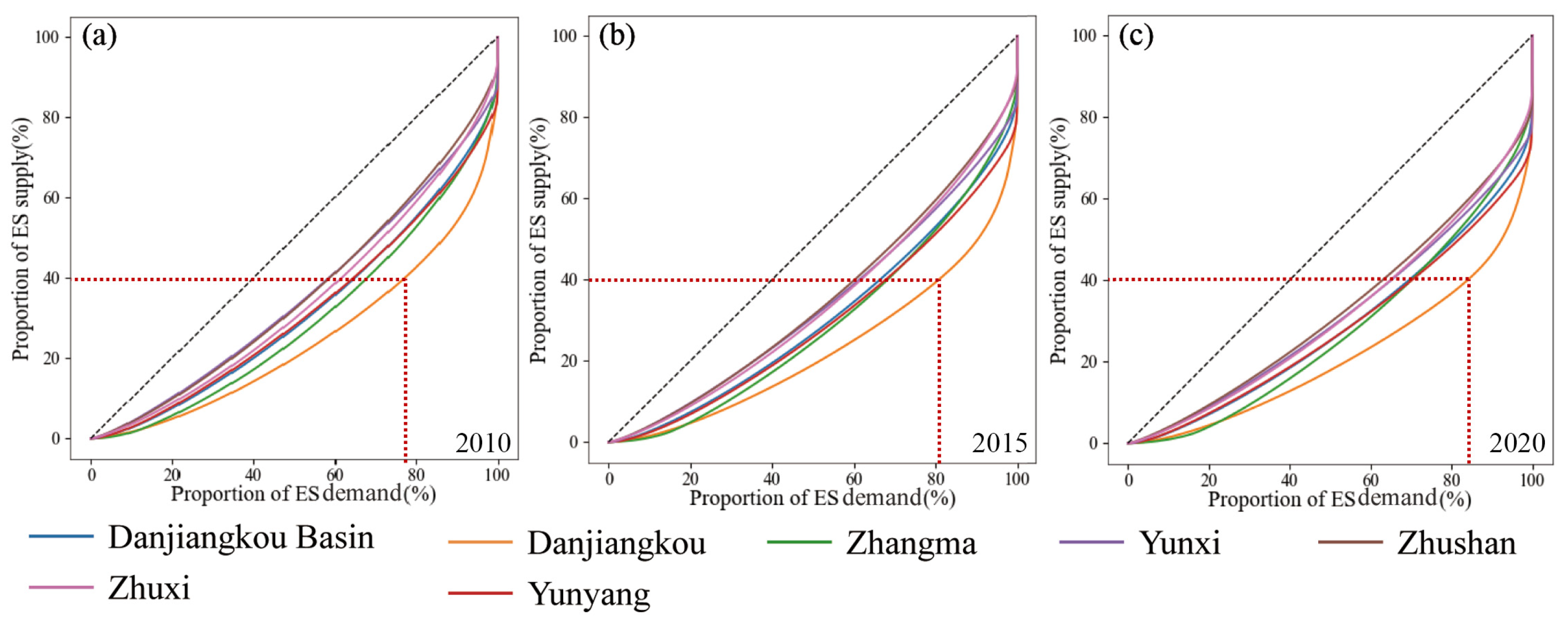


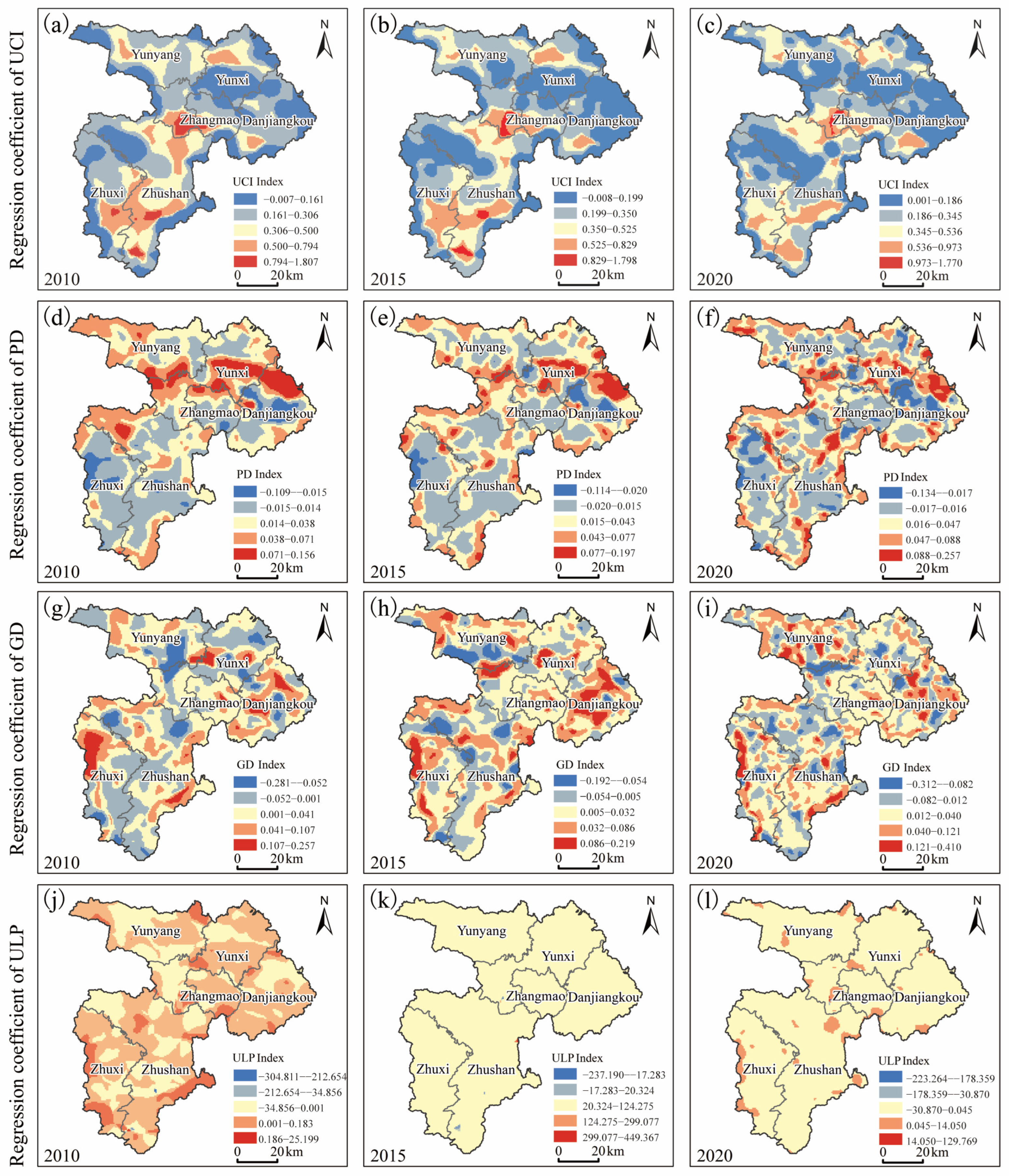

| City Year | DB | Danjiangkou | Zhangmao | Yunyang | Yunxi | Zhushan | Zhuxi |
|---|---|---|---|---|---|---|---|
| 2010 | 0.370 | 0.512 | 0.413 | 0.369 | 0.290 | 0.283 | 0.320 |
| 2015 | 0.393 | 0.545 | 0.419 | 0.415 | 0.329 | 0.307 | 0.326 |
| 2020 | 0.432 | 0.572 | 0.450 | 0.441 | 0.379 | 0.350 | 0.370 |
| Average | 0.398 | 0.543 | 0.427 | 0.408 | 0.333 | 0.313 | 0.339 |
| Year | Rural Areas | Developing Areas | Developed Areas | |||
|---|---|---|---|---|---|---|
| Proportion | Local Gini Coefficient | Proportion | Local Gini Coefficient | Proportion | Local Gini Coefficient | |
| 2010 | 74.66% | 0.108 | 19.04% | 0.307 | 6.30% | 0.518 |
| 2015 | 68.24% | 0.108 | 23.18% | 0.313 | 8.57% | 0.543 |
| 2020 | 58.67% | 0.110 | 28.89% | 0.316 | 12.44% | 0.558 |
| Average | 67.19% | 0.109 | 23.70% | 0.312 | 9.10% | 0.54 |
| 2010–2020 | −15.99% | 0.002 | 9.85% | 0.009 | 6.14% | 0.04 |
| OLS | GWR | |||||||
|---|---|---|---|---|---|---|---|---|
| Coef. | S.E. | Min. | First Qu. | Median. | Third Qu. | Max. | ||
| 2010 | Intercept | −0.259 *** | 0.0028 | −50.321 | −0.493 | −0.350 | −0.171 | 602.408 |
| UCI | 0.150 *** | 0.0015 | −0.007 | 0.142 | 0.215 | 0.375 | 1.807 | |
| ULP | 0.022 ** | 0.0135 | −304.811 | −0.002 | 0.008 | 0.021 | 25.200 | |
| P D | 0.032 ** | 0.0004 | −0.110 | 0.006 | 0.023 | 0.044 | 0.156 | |
| GD | 0.023 * | 0.0006 | −0.282 | −0.009 | 0.011 | 0.037 | 0.257 | |
| AICc | 48,072.430 | 45,741.581 | ||||||
| Adjusted R-squared | 0.607 | 0.828 | ||||||
| 2015 | Intercept | −0.245 *** | 0.0028 | −890.977 | −0.558 | −0.377 | −0.176 | 468.447 |
| UCI | 0.160 *** | 0.0015 | 0.008 | 0.151 | 0.240 | 0.386 | 1.799 | |
| ULP | 0.023 ** | 0.0135 | −237.191 | −0.002 | 0.007 | 0.020 | 449.367 | |
| PD | 0.034 ** | 0.0004 | −0.115 | 0.006 | 0.025 | 0.045 | 0.197 | |
| GD | 0.014 * | 0.0006 | −0.193 | −0.007 | 0.012 | 0.040 | 0.219 | |
| AICc | 50,882.60 | 48,795.406 | ||||||
| Adjusted R-squared | 0.653 | 0.855 | ||||||
| 2020 | Intercept | −0.223 *** | 0.0037 | −258.115 | −0.559 | −0.317 | −0.014 | 440.848 |
| UCI | 0.140 *** | 0.0013 | 0.000 | 0.125 | 0.226 | 0.382 | 1.770 | |
| ULP | 0.021 ** | 0.0106 | −223.265 | −0.002 | 0.007 | 0.019 | 129.769 | |
| PD | 0.039 ** | 0.0005 | −0.135 | 0.003 | 0.025 | 0.053 | 0.258 | |
| GD | 0.015 * | 0.0006 | −0.312 | −0.022 | 0.008 | 0.040 | 0.411 | |
| AICc | 49,736.50 | 45,902.796 | ||||||
| Adjusted R-squared | 0.648 | 0.879 | ||||||
Disclaimer/Publisher’s Note: The statements, opinions and data contained in all publications are solely those of the individual author(s) and contributor(s) and not of MDPI and/or the editor(s). MDPI and/or the editor(s) disclaim responsibility for any injury to people or property resulting from any ideas, methods, instructions or products referred to in the content. |
© 2025 by the authors. Licensee MDPI, Basel, Switzerland. This article is an open access article distributed under the terms and conditions of the Creative Commons Attribution (CC BY) license (https://creativecommons.org/licenses/by/4.0/).
Share and Cite
Liu, Q.; Lu, B.; Lin, W.; Li, J.; Lu, Y.; Duan, Y. An Improved Quantitative Analysis Method for the Unequal Supply and Demand of Ecosystem Services and Hierarchical Governance Suggestions. Land 2025, 14, 528. https://doi.org/10.3390/land14030528
Liu Q, Lu B, Lin W, Li J, Lu Y, Duan Y. An Improved Quantitative Analysis Method for the Unequal Supply and Demand of Ecosystem Services and Hierarchical Governance Suggestions. Land. 2025; 14(3):528. https://doi.org/10.3390/land14030528
Chicago/Turabian StyleLiu, Quanyi, Binbin Lu, Weikang Lin, Jiansong Li, Yixin Lu, and Yansong Duan. 2025. "An Improved Quantitative Analysis Method for the Unequal Supply and Demand of Ecosystem Services and Hierarchical Governance Suggestions" Land 14, no. 3: 528. https://doi.org/10.3390/land14030528
APA StyleLiu, Q., Lu, B., Lin, W., Li, J., Lu, Y., & Duan, Y. (2025). An Improved Quantitative Analysis Method for the Unequal Supply and Demand of Ecosystem Services and Hierarchical Governance Suggestions. Land, 14(3), 528. https://doi.org/10.3390/land14030528








